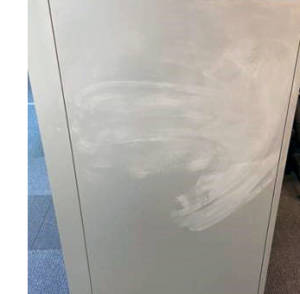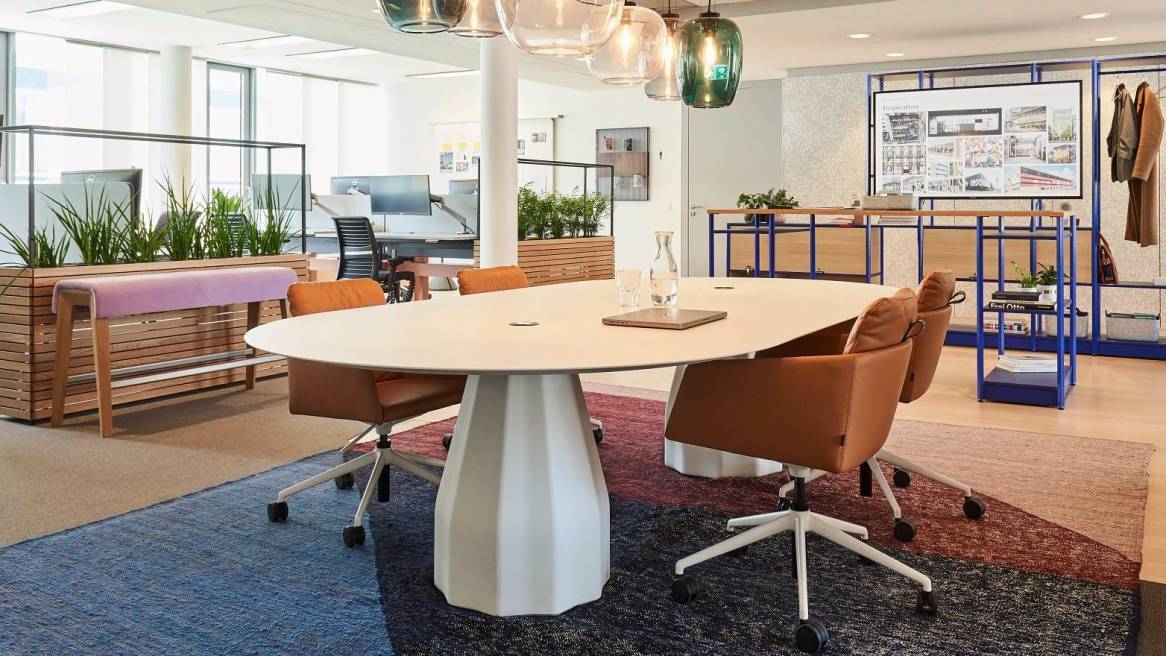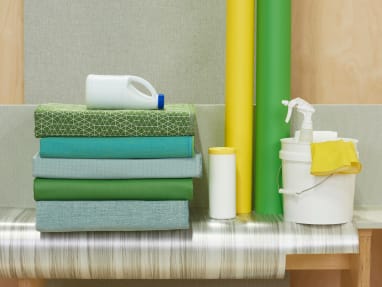Our comprehensive approach to product maintenance is based on extensive testing by our Materials Lab team. This information is our most current recommendation for how to clean and disinfect your Steelcase products. We’ll continue to update this as we learn more.
Safeguarding your Workplace Against Virus Transmission
Key considerations:
- How many people use a space on a daily basis? The more people using a space, the greater the risk of transmission.
- How often is a surface touched? For example, a table base is less likely to transmit germs than a door handle.
- How often will a space be cleaned?
These 3 factors should be considered together.
Chair controls are high-touch, but if the chair is only used by one person, that’s less concerning.
But the door handle of a frequently used meeting room is both high touch and high use, so it should be prioritized.
Bottom line: Focus on high-touch, multi-user surfaces.
Cleaning and Disinfecting Are Not the Same. But Both Are Critical.
Cleaning
Uses soap or detergent and water to physically remove germs, dirt and impurities from surfaces or objects. This process does not necessarily kill germs, but by removing them, it lowers their numbers and the risk of spreading infection.
Disinfecting
Uses chemicals to kill germs on surfaces. This process does not necessarily clean dirty surfaces or remove germs, but by killing germs on a surface after cleaning, it can further lower the risk of spreading the infection.
Cleaning products used for soil and stain removal may not be effective disinfectants. And products that disinfect may not be effective for soil and stain removal.
Stain Removal
For directions on stain removal, see the Material Cleaning and Care Instructions document.
Removing Germs
For directions on removing germs and disinfecting materials, see the guidelines on this page.
How to Sanitize your Steelcase Products
Before Cleaning Soft Surfaces
Ask yourself: Is deep-cleaning necessary?
- Fabrics rarely transmit contagions. Studies show viruses stay active on porous materials a much shorter time than nonporous surfaces.
- SARS-CoV-2, the virus that causes COVID-19, is mainly spread via aerosol.
- Coronaviruses on surfaces and objects naturally die within hours to days.*
- Scientists have found that, soap and water are enough to sanitize most surfaces against COVID-19.
- Focus efforts on high-touch, multi-user surfaces. What little risk there is of surface transmission is limited to places that a lot of people touch often, like conference room door handles or tables. Fabrics are typically on low-touch surfaces.
If you do want to deep clean soft surfaces, see instructions on the right.
Cleaning All Surfaces
1. Mix together 1 part clear dish detergent and 16 parts water in a spray bottle.
2. Spray surfaces lightly and evenly until damp. (For fabrics, the spray should be enough to coat the surface but not soak through.)
3. Let sit for 1-2 minutes.
4. For hard surfaces, wipe dry. For soft surfaces, use a wet/dry vacuum (such as a Shop Vac) to remove all moisture from the surface.
5. Allow to air dry until completely dry.
Why Soap and Water Are Enough
Is a soap and water mixture actually effective against COVID-19? Yes.
Disinfectants can destroy microbes, but they can also damage some contract materials. On the other hand, dishsoap is safe to use on all surfaces and just as effective against COVID-19. The soap attaches to the microbe … then it gets removed when you use either a Shop-Vac (on fabrics) or cloth to clear the soap and microbes from the surface.
To demonstrate proper technique for reducing risk of virus transmission without damaging your product’s finish, watch this video.
Our Stance on Antimicrobials
“ANTIMICROBIAL” ≠ “ANTI-VIRAL”
It’s important to keep in mind that the word “antimicrobial’ is a generic term, and it’s used pretty loosely. The word “antimicrobial” basically means something that destroys or inhibits the growth of microorganisms.
Most antimicrobial products only work against 1 or 2 types of microorganisms, which is why it’s important to read the fine print on any antimicrobial product claim. For example, some may work only against bacteria but not viruses.
We prefer to use the terms antiviral or “virus-inhibiting,” because these terms are specific to the microorganism of interest, SARS-CoV-2.
ARE ANTIMICROBIALS A WAY TO COMBAT COVID-19?
If a company makes these kinds of claims, read the fine print. For example, some products may be antimicrobial but only effective against bacteria. Only a few antimicrobial products have been approved by the EPA to claim efficacy against SARS-CoV-2.
The CDC still says the most effective ways of limiting the spread of coronavirus are to:
- Wash hands thoroughly and often
- Practice social distancing
- Arrange your space to facilitate social distancing
- Wear masks
- Clean surfaces that are touched by multiple people frequently
HOW WE’RE THINKING ABOUT ANTIMICROBIALS
Our Product Development teams are beginning to look at antimicrobial materials like copper. (One study found that no viable SARS-CoV-2 virus was measured after 4 hours on copper, vs. up to 72 hours on plastic and stainless steel).
We now offer a copper door handle as an option for our architectural products – ask your Steelcase salesperson or dealer for details. Solutions like these can help augment cleaning protocols and lower transmission risk.
Remember, though: Antimicrobial materials still need to be cleaned regularly.
A substance can be antimicrobial or antiviral because of:
- A chemical additive in the engineered formulation, for example in paint coatings or on fabrics;
- An inherent material attribute, for example for the substance copper, where there is an inherent mechanism in that substance that is unfriendly to microorganisms;
- Or a physical structure, like micropatterned Sharklet, which has an engineered structure that acts to repel microorganisms
Frequently Asked Questions
Can I use any cleaning products besides the ones you recommend?
| No, unless the material is specifically designed to be bleach-cleanable. (For a list of these materials, see the Finish Library and filter by “bleach cleanable.”)
Contract surface materials aren’t designed to withstand harsh chemicals. The image here shows what happened to the paint on a new Steelcase storage tower when a non-approved disinfectant was used on it. Steelcase’s Materials Lab ran over 160,000 test cycles to find which cleaning products would work against COVID-19 without damaging our products. It’s impossible to test every product and every surface material, so the ones we recommend are our best attempt at finding products that are effective and widely available. |
 |
If in doubt, test the cleaning product on an inconspicuous area before using widely. And remember: The CDC says soap and water are effective at mitigating virus spread. After all, that’s what we use on our hands!
I don’t have bleach-cleanable materials on my chairs and/or panels. How do I clean them?
See instructions on this page under “How To Sanitize Your Steelcase Products.” DO NOT use any cleaning products besides the ones we recommend. The image to the right shows the damage to the paint of a new Steelcase storage tower when someone used a non-approved disinfectant on it.
How do I clean my Steelcase office chair?
Follow the instructions on this page for how to clean both hard and soft surfaces, depending on which part of the chair you want to clean. Note, though, that …
- COVID-19 is spread mainly via aerosol, not surfaces
- Germs are mainly spread via high-touch surfaces that are touched by multiple users, like chair armcaps. (Not many people touch chair seats, for example.) If you are the only person who sits in your chair, the chance of microbe transmission is almost non-existent.
- That said, if you’d like to clean your chair, see our instructions above or watch the video.
What about some of the cleaning technologies such as electrostatic chemical sprayers or UV light? Are those safe and/or effective on Steelcase products?
The problem with these technologies is that interiors have a bunch of different materials and components (wood, metal, laminate, fabric … not to mention artwork, carpet, etc.). So using something like an electrostatic sprayer means spraying all of these surfaces with the same disinfectant, which could damage some surfaces. Therefore, we don’t recommend using this method to clean interiors that include our products.
These are some of the tests that our Materials Lab is currently conducting, and we hope to have more info soon. Until we have more data, we recommend using the products and techniques outlined on this page.
Important Notes Regarding These Cleaning Instructions
- For the latest information on potential exposure pathways for COVID-19 infection, including contact with surfaces, please see the World Health Organization website.
- Please work with your Facilities staff to determine how frequently your products should be cleaned.
- Proper personal protection equipment (PPE) such as gloves and eye protection, as directed by the cleaner manufacturer, must be worn.
- To avoid risks of fire or shock, always disconnect electrical power when cleaning products that use or provide electricity.
- Be careful not to allow liquids to enter any openings in electrical products.
- Due to the wide variation in the end use of these cleaning products (including amount of product applied, elapsed time before removal from the surface, physical action used to remove the cleaner, and the number of applications), your results may vary from the test results used to develop this guide.
- If you are unsure about the use of a given cleaner on a surface, please test it first on a small, inconspicuous area before proceeding with a broader cleaning program.
- These guidelines apply only to products manufactured by Steelcase. For guidance on cleaning other products, refer to the manufacturer of those products’ manufacturers.
- Steelcase cannot make a determination of the effectiveness of a given disinfectant product in fighting pathogens, such as COVID-19. Please refer to your local public health authority’s guidance on how to stay safe from potential infection.



